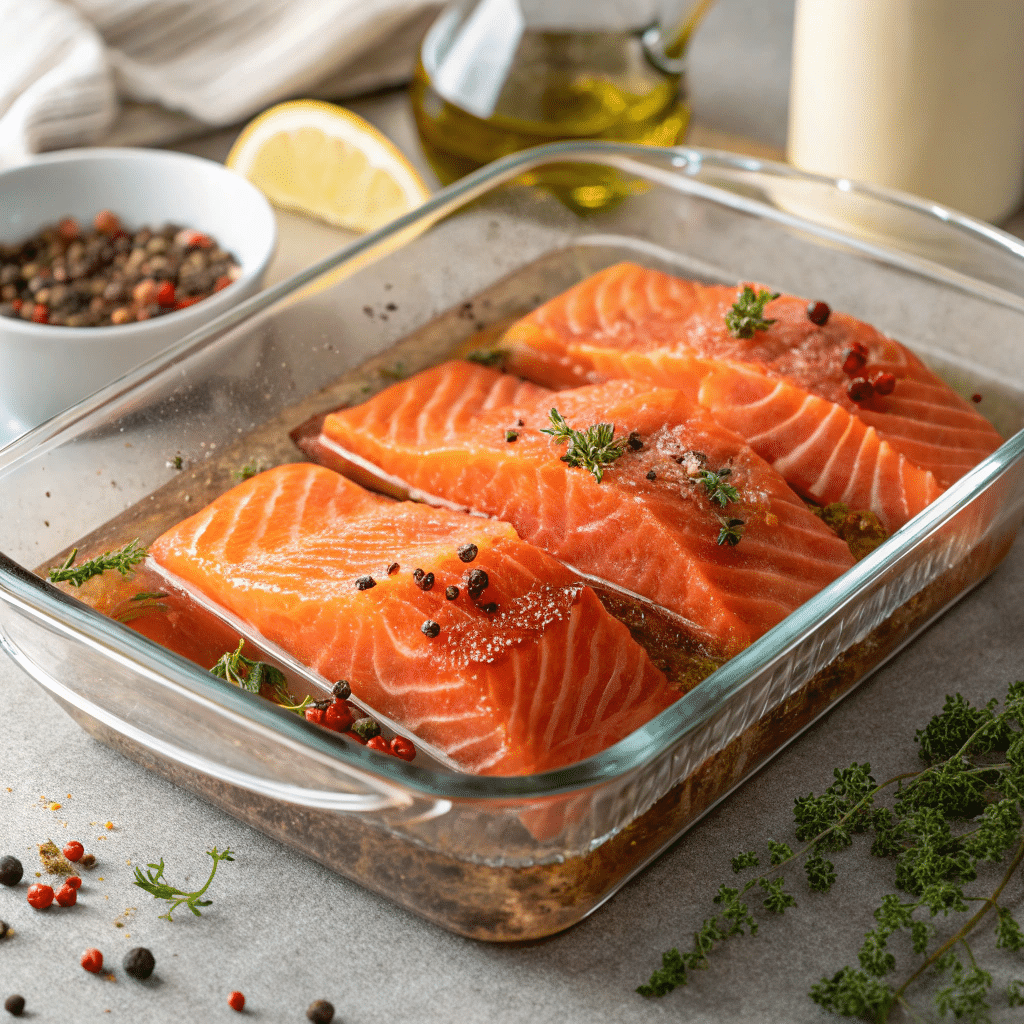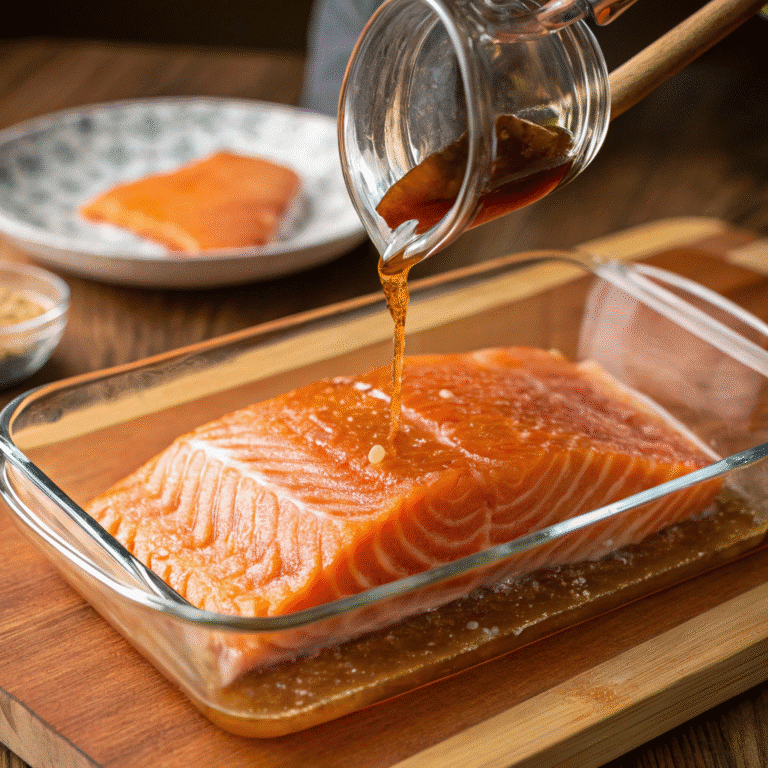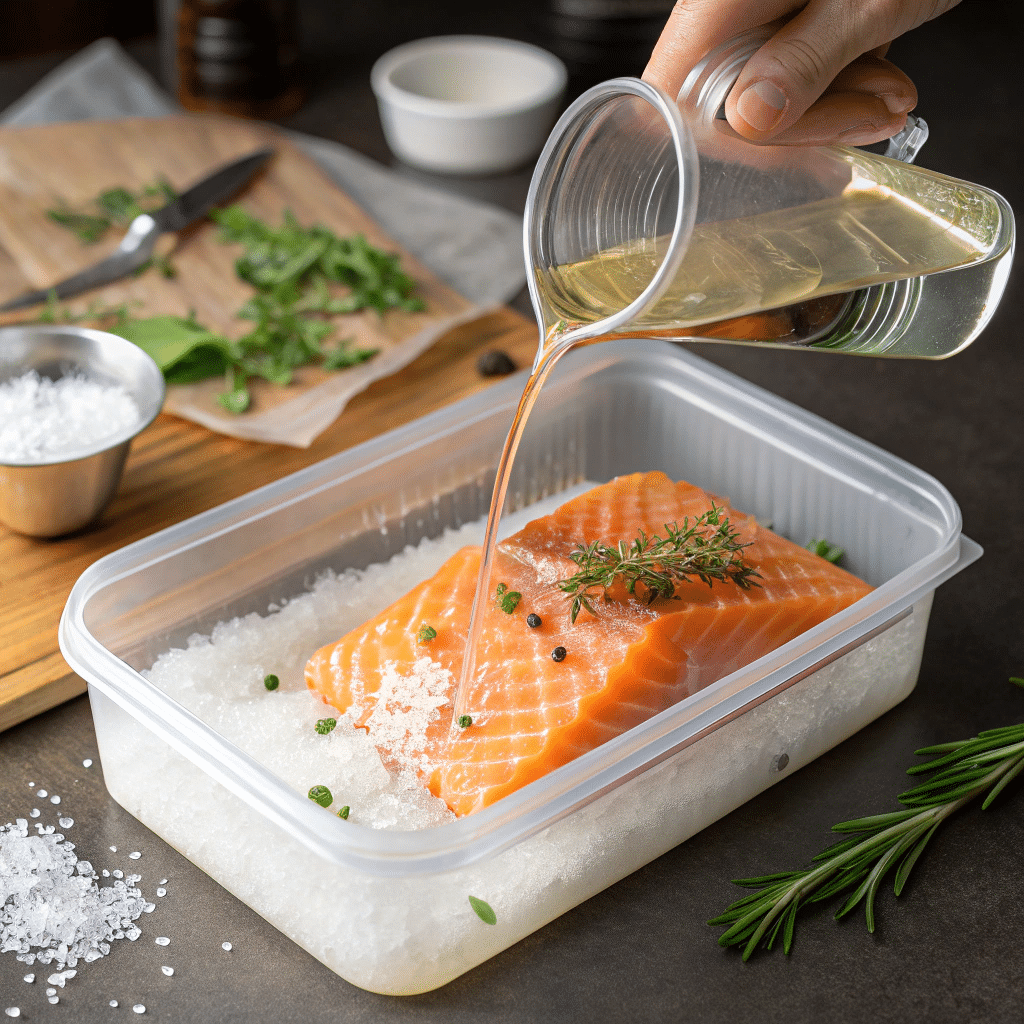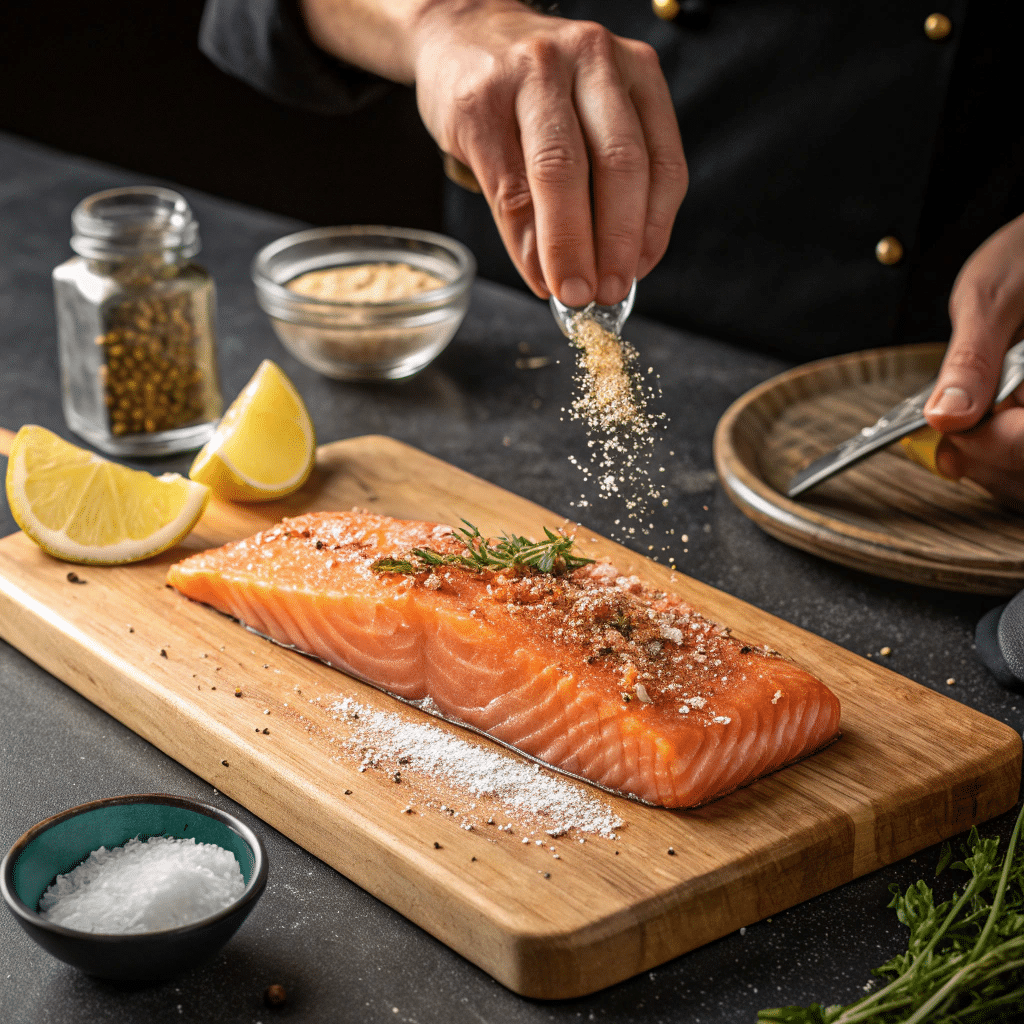If you’re craving the perfect smoked salmon, the secret isn’t just in the smoke — it starts with the smoked salmon brine. Brining lays the groundwork for rich flavor, tender texture, and longer-lasting freshness. Whether you’re a home cook or a backyard BBQ enthusiast, knowing how to brine salmon properly will elevate your smoked salmon from good to unforgettable.

This comprehensive guide covers everything you need to know about smoked salmon brine: from classic salt-and-sugar mixes to bold herbal infusions, and from wet vs. dry brines to pro tips on timing and temperature. You’ll learn how to avoid common mistakes, improve flavor depth, and ensure food safety while maximizing that irresistible smoky taste.
Print
Smoked Salmon Brine
The ultimate smoked salmon brine for tender, flavorful fish. Perfect for hot or cold smoking. This simple brine ensures balanced flavor and ideal texture every time.
- Total Time: 12 hours 10 minutes
- Yield: Brines up to 2 pounds fish
Ingredients
4 cups cold water
1/2 cup kosher salt
1/2 cup brown sugar
2 garlic cloves (crushed)
2 bay leaves
1 tablespoon black peppercorns (optional)
2 sprigs fresh dill (optional)
Zest from 1 lemon (optional)
Instructions
In a large glass or plastic container, combine cold water, kosher salt, and brown sugar. Stir until fully dissolved.
Add garlic, bay leaves, and any optional herbs or zest. Mix well.
Submerge salmon fillets completely in the brine. Cover and refrigerate for 8–12 hours.
After brining, remove the salmon. Rinse lightly and pat dry with paper towels.
Let salmon air-dry on a wire rack for 1–2 hours until a pellicle forms.
Smoke using your preferred method (hot or cold).
Serve and enjoy, or refrigerate for up to one week.
Notes
Do not reuse brine after it’s been used once.
Adjust brining time based on fillet thickness.
Add maple syrup or chili flakes for flavor variations.
Works for steelhead trout or arctic char too.
- Prep Time: 10 minutes
- Brine Time: 8 hours
- Cook Time: 4 hours
- Category: Brine, Smoking Prep
- Method: Wet Brining
- Cuisine: American, BBQ
Nutrition
- Serving Size: 4 oz
- Calories: 210
- Sugar: 2g
- Sodium: 480mg
- Fat: 9g
- Saturated Fat: 2g
- Unsaturated Fat: 6g
- Carbohydrates: 3g
- Protein: 26g
- Cholesterol: 45mg
Let’s dive into the flavorful world of brining and learn why it’s the most critical step in preparing smoked salmon that’s tender, juicy, and full of rich taste
If you like this recipe, check out some of my other favorite salmon dinners!
- Smoked Salmon Sandwich At Home – How To Make A Delicious
- Cold Smoked Salmon: Everything You Need – How To Make
Understanding Smoked Salmon Brine Basics
What is Smoked Salmon Brine and Why It’s Essential
Smoked salmon brine is a salt-based solution—often combined with sugar, herbs, and spices—used to soak raw salmon before smoking. This process doesn’t merely flavor the fish — it elevates it into something entirely new. Brining enhances flavor, boosts moisture retention, firms up the flesh, and extends shelf life.
Table of Contents
Without brine, smoked salmon can turn out dry, bland, or overly smoky. That’s why professional chefs and backyard smokers alike rely on this essential step. Whether you’re aiming for a subtly sweet lox or a deeply savory smoked fillet, the brine is where it all begins.
There are two primary types: wet brine (a liquid solution) and dry brine (a salt rub without added liquid). Each has its perks, and we’ll explore both options in-depth later. But first, let’s understand what happens when salmon meets brine.
The Science Behind Brining and Flavor Infusion
Brining works through a process called osmosis. When salmon sits in a salty solution, moisture from the fish is drawn out and replaced with brine, carrying salt, sugar, and any added flavors deep into the flesh. The result? Richer taste and a firmer texture, which holds up better during the smoking process.
Salt is the hero ingredient here. It not only seasons the salmon but denatures proteins, tightening the flesh and locking in juiciness. Sugar, on the other hand, balances out saltiness, adds subtle sweetness, and promotes beautiful browning during smoking.
Brining also plays a safety role. It reduces water activity in the salmon, helping prevent the growth of harmful bacteria during the cold smoking phase—especially when smoking below 90°F.
Best Brine Recipes for Smoked Salmon
Classic Salt and Sugar Brine Recipe
When it comes to preparing the perfect smoked salmon brine, the classic salt-and-sugar mixture is a proven winner. This classic brine not only infuses the fish with flavor but also locks in its tenderness and deepens its distinctive smoky character.
A simple base recipe for smoked salmon brine includes:
| Ingredient | Amount |
|---|---|
| Cold Water | 4 cups |
| Kosher Salt | 1/2 cup |
| Brown Sugar | 1/2 cup |
| Garlic (optional) | 2 cloves, crushed |
| Bay Leaf (optional) | 1 or 2 leaves |
Stir until salt and sugar are dissolved. Submerge your salmon in this smoked salmon brine for 8 to 12 hours, depending on thickness. The result? A perfectly seasoned, firm piece of salmon ready for the smoker.
Using this base, you’ll create consistent results every time—salmon that stays moist, flavorful, and smoke-ready.
Sweet, Spicy, and Herbal Variations
Once you’ve mastered the basic smoked salmon brine, try experimenting with bold new flavor combinations. Add-ins like maple syrup or honey can enhance sweetness, while ingredients like chili flakes or cracked black peppercorns turn up the heat.
Herbs such as dill, thyme, and oregano can be steeped into the brine for an aromatic layer, especially when matched with light smoking woods like cherry or alder. For an extra twist, squeeze in lemon juice or add zest to cut through the richness of the salmon.
Using these variations in your smoked salmon brine gives you endless flexibility depending on the meal, season, or smoking wood.
Choosing the Right Ingredients for Brining
Salt Types: Kosher, Pickling, and Sea Salt
The kind of salt you use in your smoked salmon brine matters. Kosher salt is the most popular choice—it dissolves well, is additive-free, and gives a clean, mild flavor.
Pickling salt is another good option, especially if you want a finer grain that blends easily into cold water. Sea salt works too but can vary in mineral content and strength, so use it carefully to avoid over-salting.
Never use iodized table salt—it contains additives that can leave a metallic taste and cloud your brine.
Flavor Enhancers: Brown Sugar, Herbs, and Spices
Once you’ve nailed the salt balance, it’s time to layer in flavor—brown sugar brings a rich depth and a whisper of caramel sweetness to your smoked salmon brine. For a more savory version, try herbs like dill, thyme, or bay leaf.
Want complexity? Add crushed garlic, peppercorns, or even citrus zest. You can also use soy sauce or mustard seeds to introduce unique undertones.
These small additions customize your smoked salmon brine to match any wood smoke—from alder and cherry to mesquite or hickory.
Step-by-Step Guide to Brining Salmon
How to Prep Salmon Before Brining
Before adding salmon to your smoked salmon brine, proper prep ensures even flavor and safe smoking. First, remove pin bones using tweezers. Then, rinse the fillet and pat it dry with paper towels.

If your salmon has scales, you can leave them on—this helps protect the flesh during smoking. For large fillets, cut into even portions so the brine penetrates uniformly. This prep step also reduces brining time and improves consistency.
Refrigerate your salmon while preparing the brine to keep it cool and fresh.
Exact Process and Brining Time Explained
Now, let’s get into the actual brining:
- Prepare the brine: Stir salt, sugar, and any aromatics into cold water until completely dissolved. For a dry cure: Blend the dry ingredients thoroughly, then rub the mixture evenly over the surface of the.
- Gently immerse the salmon: Lay the fish in a non-metallic container, such as glass or plastic, to avoid any unwanted reactions. Pour the wet smoked salmon brine over it or rub in the dry mixture.
- Refrigerate: Cover and let sit in the fridge. Most salmon needs 8–12 hours in brine. For thinner cuts, 6 hours may be enough. Avoid overbrining—it can toughen the texture.
- Lift and dry: Carefully remove the salmon from the brine and gently pat it dry with paper towels. For best results, let the salmon air-dry on a rack for 1–2 hours until a thin glaze (pellicle) forms. This helps the smoke stick and enhances the final texture.
This process locks in moisture, adds flavor, and preps your fish for the next stage—smoking.
Wet Brine vs Dry Brine for Smoked Salmon
Pros and Cons of Wet Brining
Wet brining is a popular go-to for prepping salmon before smoking. This method soaks the fish in a seasoned saltwater blend, often enhanced with sugar and aromatic spices for deeper flavor. This approach is ideal for large batches and ensures even flavor absorption throughout the fish.

Pros:
- Even seasoning across the fillet
- Great for infusing herbs, spices, and sweeteners
- Adds moisture to lean fish during smoking
Cons:
- Requires more space (large container + fridge)
- Longer drying time before smoking
A reliable wet brine recipe is ideal for beginners, delivering consistently moist and flavorful smoked salmon every time.
When to Use Dry Brine and How to Apply It
Dry brining skips the water. Instead, the salmon is coated with a blend of salt and sugar, then left to cure in the refrigerator. This process pulls out moisture, which later reenters the fish infused with flavor—intensifying the taste and giving the flesh a firmer texture.
Use dry brine when:
- You want stronger flavor in a shorter time
- You’re working with thinner cuts or filets
- You don’t want to deal with large containers of liquid
How to apply:
Mix kosher salt and brown sugar in a 2:1 ratio. Rub generously onto all sides of the salmon. Wrap the fish in plastic or place it in a shallow dish, then refrigerate for 4–8 hours. Rinse lightly and dry before smoking.
Dry brining also produces a thinner pellicle (the sticky surface layer), which creates a deeper smoke flavor.
Common Mistakes to Avoid When Brining Salmon
Overbrining and Underbrining Explained
Timing is everything when working with smoked salmon brine. One of the most common mistakes is overbrining—soaking the fish too long. This can lead to overly salty salmon with a rubbery texture. On the flip side, underbrining leaves the fish bland and unseasoned.
Here’s a simple brining time guide:
| Salmon Thickness | Wet Brine Time | Dry Brine Time |
|---|---|---|
| Thin (<1 inch) | 4–6 hours | 2–4 hours |
| Medium (1–1.5 in) | 6–10 hours | 4–6 hours |
| Thick (>1.5 inch) | 10–12 hours | 6–8 hours |
Set a timer and stick to it. And always adjust based on the size and cut of your fillet.
Brining Temperature and Storage Tips
Always brine your salmon in the refrigerator—never at room temperature. Warmer conditions can promote bacterial growth and risk spoiling the fish. Keep the brining container covered and avoid using metal bowls—they can react with salt and affect flavor.
After brining, don’t skip the drying phase. Letting the salmon air-dry forms a pellicle, a tacky layer that helps smoke adhere and creates that beautiful finish you want.
Pro tip: If your fridge smells strongly of other foods, seal the brining container tight to avoid flavor transfer.
Smoking Brined Salmon the Right Way
Pre-Smoking Steps After Brining
Once your salmon finishes soaking in a smoked salmon brine, don’t rush to the smoker. First, remove it from the brine and give it a gentle rinse—this helps wash away any excess salt or sugar. Next, gently blot the salmon with clean paper towels to get it ready for the smoker.
Let the salmon rest on a wire rack in the fridge for 1–2 hours. This essential step forms a pellicle—a tacky surface layer that helps the smoke cling evenly to the salmon. Without this drying stage, the smoky flavor won’t stick properly, and the texture may turn out soft or uneven.
This drying process enhances the flavor development that your smoked salmon brine started.
Smoking Time, Wood Types, and Temperatures
Now it’s time to smoke your salmon. The ideal method varies based on whether you’re cold or hot smoking—and on the specific flavors used in your brine.
Cold Smoking Method
- Temperature: 70–90°F
- Time: 8–12 hours
- Recommended Woods: Alder, Applewood
- Style: Lox-like texture, often sliced thin
- Brine Tip: Cold-smoked salmon works best with a sweeter or more aromatic smoked salmon brine
Hot Smoking Method
- Temperature: 180–200°F
- Time: 2–4 hours
- Recommended Woods: Cherry, Maple, Hickory
- Style: Flaky, cooked texture, ready to eat
- Brine Tip: Use a saltier or spicier smoked salmon brine to counterbalance stronger smoke flavors
For safety, make sure the salmon hits an internal temperature of 145°F when hot-smoking. To keep it moist—particularly if your brine was on the saltier side—spritz the fish hourly with water or apple juice.
Every wood pairs differently with the flavors your brine developed. Sweet brines match well with cherry or maple, while herbal or spicy brines go nicely with hickory or oak.
Storing and Using Leftover Brine
Can You Reuse Smoked Salmon Brine Safely?
One of the most common questions from DIY smokers is: Can I reuse smoked salmon brine? The short answer? No—it’s not recommended. After soaking raw salmon, the brine picks up proteins, oils, and possibly harmful bacteria, making it contaminated.
Even if it looks and smells fine, reusing the same smoked salmon brine can pose serious food safety risks. Discard it after each use to avoid cross-contamination, especially when cold smoking. No shortcut is worth risking foodborne illness.
However, if you want to replicate the flavor of a successful batch, write down your brine ratio and reuse the same formula—not the actual liquid.
Tips for Storage, Freezing, and Disposal
If preparing your smoked salmon brine ahead of time, keep it sealed in an airtight container and refrigerate. It will stay fresh for up to 5 days, as long as it hasn’t touched raw fish.
For bigger batches or extended storage, freeze any unused brine (prior to use) in zip-lock bags or containers. When ready to smoke again, thaw it slowly overnight in the refrigerator.
Proper disposal matters too. Don’t pour used brine down the sink if it’s heavily salted—it can corrode pipes. Alternatively, transfer it to a single-use container and dispose of it in the garbage.
Nutrition, Safety, and Flavor FAQs
Is Smoked Salmon Healthy After Brining?
Yes, smoked salmon brine can contribute to a healthy meal—when balanced. The brining process itself doesn’t add calories, but it does increase sodium levels. If you’re watching your salt intake, you can adjust the salt-to-water ratio or choose a shorter brining time.
Home-prepared hot smoked salmon, crafted from lean fillets with just a touch of sugar, is a rich source of omega-3 fatty acids, high-quality protein, and essential B vitamins. It’s a nutritious option when paired with fresh salads, whole grains, or low-sodium sides.
The key is moderation and balance—especially when using a traditional brine with both salt and sugar.
How Brining Affects Taste and Shelf Life
A well-made smoked salmon brine deeply enhances the flavor profile of the fish. It infuses saltiness, sweet undertones, and aromatic layers that smoke alone can’t achieve. This flavor depth is what sets smoked salmon apart from simple baked or grilled fish.
In terms of shelf life, brining helps by drawing out moisture, making it harder for bacteria to grow. When smoked and properly stored, salmon can last:
- Cold smoked: Keeps fresh for up to 10 days in the fridge and up to 2 months when frozen.
- Hot smoked: 7–10 days refrigerated, 2–3 months frozen
Vacuum-sealing extends freshness, especially when your brined salmon is intended for future meals.
Frequently Asked Questions (FAQs)
What is the best brine for smoked salmon?
The best smoked salmon brine balances salt, sugar, and added aromatics. A classic base is a 4:1 ratio of water to kosher salt, with equal parts brown sugar to sweeten. From there, you can enhance flavor with garlic, bay leaves, black peppercorns, dill, or citrus zest. For cold smoking, brines that are sweeter, incorporating ingredients like maple syrup or honey, are ideal. In contrast, hot smoking is enhanced by bolder, spicier, or savory flavors such as mustard seeds or soy sauce.
How long should salmon be brined before smoking?
The duration for brining varies based on the size and thickness of your fish. Generally, salmon should be brined for 6–12 hours in a wet brine, or 4–8 hours with a dry brine. Thin fillets might require just a few hours, whereas thick center cuts gain from extended curing times. The key is consistency—don’t overbrine, as it can make the fish too salty or rubbery.
Do you rinse salmon after brining before smoking?
Yes, it’s recommended to rinse salmon after removing it from the smoked salmon brine—especially with dry brine methods. A gentle rinse removes excess salt and sugar from the surface, preventing overpowering flavors and caramelized crusts during smoking. After rinsing, thoroughly dry the salmon by patting it with a towel, then let it sit uncovered on a rack for 1 to 2 hours so a pellicle can develop.
Can I reuse smoked salmon brine?
No, smoked salmon brine should never be reused. Once raw fish comes into contact with the brine, bacteria and proteins transfer into the liquid, contaminating it. Reusing it—even if refrigerated—can lead to foodborne illness. Never reuse brine; always make a new batch fresh for every smoking session.
Conclusion
Perfecting the smoked salmon brine unlocks the secret to taking your homemade smoked fish to the next level. Grasping the balance of salt and sugar and deciding on a wet or dry brine—your prep work before smoking truly shapes the final result. With the right brine, your salmon will come out perfectly seasoned, moist, and packed with rich smoky flavor.
Whether you’re hot-smoking for tender flakes or cold-smoking to achieve that classic lox texture, be sure not to skip the drying step and the essential brine safety guidelines we discussed. And remember, customizing your brine with herbs, spices, or sweeteners lets you make each batch uniquely yours.
Follow us on Facebook at how to cooking recipes for daily recipe inspiration and kitchen tips.
